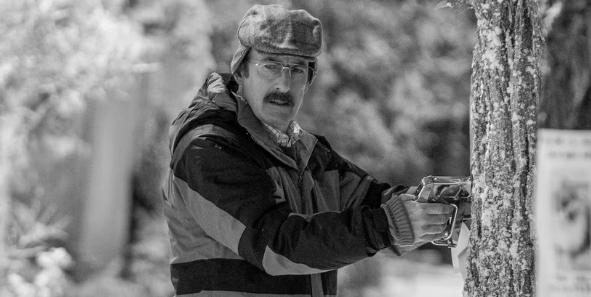I’ll Forever Defend This Better Call Saul Episode Everyone Seemed To Hate
A lot of Better Call Saul fans seemed to really hate season 6, episode 10, “Nippy,” but I think it’s massively underrated – and a great episode of television. Season 6 marked the end of Better Call Saul’s run, and it was burdened with wrapping up both the pre-Breaking Bad Lalo Salamanca storyline and the black-and-white post-Breaking Bad Nebraska Gene storyline. The wrap-up of the Lalo storyline was just as thrilling and action-packed as anything in Breaking Bad, but the wrap-up of the Gene storyline was much quieter and more contemplative than Breaking Bad ever was.
The slow burn of the Gene storyline began in “Nippy,” which focuses entirely on Gene’s life in Nebraska. While “Nippy” was well-received by critics, earning a near-perfect 90% approval rating on Rotten Tomatoes, it was met with a more mixed response from audiences. But the audience reception suffered because audiences were expecting something different than what the show delivered. “Nippy” wasn’t criticized because of what it was; it was criticized because of what it wasn’t – and it’s a great episode of Better Call Saul, so it deserved so much more than that.
Why So Many People Disliked Better Call Saul’s “Nippy” When It Aired

“Nippy” opens with Gene putting up missing dog posters and bumping into an elderly woman named Marion, played by Carol Burnett. It eventually turns out that Marion is the mother of Jeff, the taxi driver who appeared in previous seasons and identified Gene as Saul Goodman. Gene offers Jeff a chance to get in on “the game” by robbing a department store, and they set about plotting a heist at the same mall where Gene works at Cinnabon. On its own, it’s a great little small-town crime story and an interesting development in the show’s Nebraska-set sequel timeline.
But after the rapid-paced, action-packed season 6 episodes that came before it, “Nippy” felt like the writers had slammed their foot down on the brakes. The first half of season 6 wrapped up with episode 7, “Plan and Execution,” which ended with Lalo executing Howard in Jimmy and Kim’s apartment. This was followed up by the midseason premiere – episode 8, “Point and Shoot” – in which Jimmy and Kim are forced to help Lalo get revenge against Gus. After these episodes, audiences were expecting the rest of the season to maintain this intensity right up to the finale.
And then “Nippy” came along with its slow pacing, its black-and-white palette, and its decidedly action-free story of Gene training a hopeless cab driver to become a small-time crook. Anyone who was expecting another bombshell moment like Lalo executing Howard or Gus executing Lalo was bound to be underwhelmed by “Nippy.” Some fans even complained that “Nippy” felt like filler, in spite of its subtle but game-changing developments in the Gene storyline. “Nippy” was actually a great episode; it’s just that, after “Plan and Execution” and “Point and Shoot,” people were expecting another action-packed episode full of mind-blowing twists.
“Nippy” Is Actually A Fantastic Better Call Saul Episode

I remember when Better Call Saul season 6 was airing and fans were following the final episodes week by week. “Nippy” did feel like a jarring change of pace after the explosive plot twists and character deaths of “Plan and Execution” and “Point and Shoot” – but that didn’t mean it was bad. It just meant that Better Call Saul’s brilliant writers were keeping the audience on their toes, just as they’d done throughout the series’ entire run. “Nippy” was the payoff to six seasons’ worth of Gene-centric flash-forwards; it finally gave Gene the spotlight for a whole episode.
Ever since Jeff identified Saul, Better Call Saul’s writers had kept the audience guessing about how it would shake out. Forging an unlikely alliance between Jeff and Gene as Gene teaches Jeff his old Slippin’ Jimmy ways was both an unexpected way to continue this story thread and a perfect way to peel back the many layers of Jimmy McGill. Jimmy might have changed his name and settled into a mundane life as a Cinnabon manager, but he’s still a trickster at heart. He’s not just planning the heist to get Jeff off his back; he’s reliving his glory days.
“Nippy” was a fascinating exploration of Jimmy’s psyche, which showcased the depth and range of Bob Odenkirk’s performance. When Jeff falls unconscious and the security guard Jimmy is distracting turns to look at the CCTV monitor, Jimmy makes the snap decision to feign a depressive episode. This is one of Better Call Saul’s many Emmy-worthy scenes, because in Jimmy’s fake depressive spiral, he babbles about letting down his brother. Odenkirk’s performance demonstrates that, while the breakdown is fake, there are some real emotions buried in it. This exemplifies Better Call Saul’s ability to do so much more than just action.
Better Call Saul Season 6 Set The Bar Way Too High

Better Call Saul’s final season created a rod for its own back with the shocking midseason twist. Howard’s death was one of the most harrowing moments in TV history. I’m glad the next episode didn’t arrive until nearly two months later, because that’s how long I needed to process Howard’s death. It was an interesting choice for the writers to pivot to a slower, quieter episode after these action-packed twists. But the action-packed twists were so effective – and had fans so excited to see more action-packed twists – that the writers managed to undermine their own subversion of the audience’s expectations.
“Nippy” Is Better Call Saul’s Version Of Breaking Bad’s “Fly”

“Nippy” is Better Call Saul’s answer to Breaking Bad season 3, episode 10, “Fly.” “Fly” is essentially a bottle episode in which a fly manages to get into the lab. Walt and Jesse spend the whole episode trying to get this fly so there won’t be any possible contamination in their latest batch of meth. The reception to “Fly” was just as mixed as “Nippy.” Reviews ranged from calling it the best episode of Breaking Bad so far to a pointless bit of filler that turned Walt into a buffoon.
The third season of Breaking Bad had just as many shocking twists and visceral action sequences as the final season of Better Call Saul. When “Fly” arrived between Hank getting attacked by the Cousins and Walt running over a couple of drug dealers to save Jesse, it was – much like “Nippy” – a drastic change of pace. On the initial week-to-week viewing of the series, that slower pacing was jarring. But taken on their own merits, both “Nippy” and “Fly” are terrific episodes of television.



